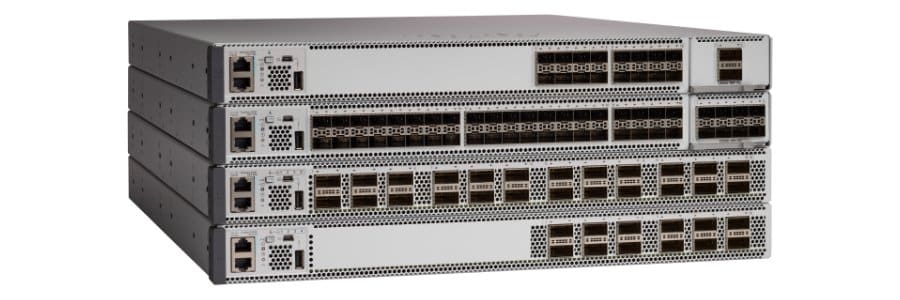Today, the essential role of network switches in ensuring seamless communication and data transfer cannot be overstated more than ever. Among the numerous options, Cisco network switches have carved a niche. These switches are known for their robust performance, advanced features, and reliability, making them the backbone of many enterprise networks. This blog aims to provide a deep understanding of Cisco network switches, their importance across various industry sectors, the challenges associated with transitioning to them, and a step-by-step guide for making the transition.
Let’s start with understanding the components of a Cisco network switch.

Understanding Cisco Network Switches
Cisco network switches are not just networking devices, but specialized tools designed for business environments. They connect various devices on a computer network and use packet switching to receive, process, and forward data to the desired destination. These switches offer high-speed and secure data transfer, enhanced efficiency, and better control over network traffic.
Key features include:
- Advanced security protocols.
- Quality of Service (QoS) for improved network performance.
- Power over Ethernet (PoE) capabilities.
- Robust VLAN functionalities.
Innovative technologies like Digital Network Architecture (DNA) and Intent-Based Networking (IBN) set Cisco’s network switches apart, which offer predictive analytics and automation for superior network management.

Importance of Cisco Network Switches in Various Industry Sectors
Enhanced Data Transfer Speed
In sectors like financial services and healthcare, where real-time data transfer is necessary, Cisco network switches ensure fast and efficient data transfer, thereby improving operational speed.
Here are a variety of technologies to ensure fast and efficient data transfer, including:
- Layer 2 switching: This technology enables switches to rapidly transmit data packets between devices within the identical network segment.
- Layer 3 routing: This technology allows switches to route data packets between different network segments.
- QoS (Quality of Service): This technology allows switches to focus on certain types of traffic, such as voice or video, to ensure they are not delayed or dropped.
Improved Network Security
Cisco Network Switches are crucial in improving network security for wholesale, manufacturing, and real estate industries by providing advanced features such as access control, network segmentation, intrusion prevention, and real-time monitoring. These features enable organizations in these sectors to protect sensitive data, maintain operational efficiency, and adapt to evolving security threats.
Scalability
Cisco network switches offer a range of scalability options, from physical expansion and modular design to virtualization and cloud integration. In addition, various models are provided with different port densities. As your industry grows, you can add more switches or switch modules to increase the number of available network ports. This accommodates the addition of more devices and users to the network.
Reliability
Any network downtime can lead to significant operational disruptions in sectors like manufacturing and logistics. Cisco’s network switches are known for their reliability, ensuring uninterrupted network connectivity.
They provide an array of features aimed at enhancing reliability, including:
- Hot-swappable components: You can replace failed components without shutting down the switch.
- Redundancy: This feature allows for multiple paths between devices so that the traffic can be routed over another path if one path fails.
- Resiliency: This feature allows the switch to recover from failures quickly.
Enhanced Communication
Cisco switches benefit industries with enhanced communication capabilities like VoIP, video conferencing, and collaboration tools.
- VoIP (Voice over IP): This technology enables you to initiate and receive phone calls over the network.
- Video conferencing: This technology allows you to converse with people over the network.
- Collaboration tools: This technology allows you to share files, documents, and ideas with others over the network.
Easy Integration
Cisco network switches can easily integrate with other Cisco products, such as routers, firewalls, and wireless access points. This makes it easy to create a comprehensive and integrated network infrastructure.
Cloud Readiness
Numerous Cisco switches are prepared for cloud deployment, facilitating their easy setup and management within cloud environments. A few of the advantages that Cisco switches provide to an organization migrating to cloud-based solutions include the following:
- Easy deployment and management: Cloud-ready Cisco switches can be deployed and managed through a cloud-based management console like Cisco DNA Center. This makes it easy to provision and configure switches and monitor their performance and health.
- Scalability: Cloud-ready Cisco switches can be easily scaled up or down to meet the changing demands of cloud-based applications.
- Security: Cloud-ready Cisco switches offer a variety of security features to protect cloud-based applications and data from threats.
- Reliability: Cloud-ready Cisco switches are designed to be reliable and offer various features to improve uptime, such as redundancy and resiliency.

Challenges in Transitioning to Cisco Network Switches
Lack of Technical Expertise
Configuring and maintaining Cisco network switches can be a complex task requiring specialized knowledge. Many organizations face challenges due to the absence of personnel with the necessary expertise. This can lead to potential misconfigurations, security vulnerabilities, and inefficient network performance.
Compatibility Issues
Transitioning to Cisco network switches may introduce compatibility issues with existing network infrastructure. Different switch models or software versions may not seamlessly integrate with your current hardware and software components. You’ll want to discuss your current network hardware’s compatibility with the Cisco switches in detail prior to migration.
High Cost
Cisco network switches are known for their high-quality performance but are also a serious financial investment. For some businesses, the initial investment required to acquire Cisco switches can be a significant financial cost. Considering this transition, it’s crucial to weigh the long-term benefits against the upfront costs.
Downtime during Transition
During the transition phase, there is a possibility of downtime that can impact business operations. As you replace or reconfigure network switches, there may be interruptions in connectivity and services. Minimizing downtime through careful planning and execution is essential to mitigate the negative impact on productivity and customer satisfaction.

Transitioning to Cisco Network Switches
Assessing Your Current Network Infrastructure
Before transitioning to Cisco network switches, comprehensively assess your current network infrastructure. This step involves evaluating your network topology, hardware, and software configurations. Assess both the strengths and weaknesses of your existing configuration to identify the necessary enhancements.
Identifying the Appropriate Cisco Network Switch
Research various Cisco switch models and series to identify the one that best aligns with your business needs and network size. Consider factors such as port density, data throughput, PoE (Power over Ethernet) requirements, and compatibility with your existing equipment.
Planning the Network Design
Create a detailed network design plan that outlines the structure and layout of your new network. Consider network size, scalability requirements, redundancy, and future growth projections. A well-thought-out design ensures that your network can efficiently accommodate current and future demands.
Acquiring the Cisco Network Switches
Purchase Cisco network switches from an authorized partner or distributor to ensure you receive genuine products with valid warranties and support. Verify that the switches meet all the required specifications and are compatible with your planned network design.
Configuring the Cisco Network Switches
Use Cisco IOS (Internetwork Operating System) to configure the switches according to your network requirements. This includes setting up VLANs (Virtual LANs), implementing Quality of Service (QoS) policies, and configuring security features like access control lists (ACLs) and port security. Proper configuration is essential for network stability and security.
Installing and Testing the Cisco Network Switches
Physically install the Cisco network switches in designated locations within your network infrastructure. Following installation, perform comprehensive testing to confirm that the switches operate as anticipated. Validate connectivity, data transmission, and their ability to communicate with other network devices.
Training Staff
Invest in training programs for your IT staff to equip them effectively with the knowledge and skills required to manage and troubleshoot Cisco network switches. Well-trained staff can minimize downtime, promptly resolve issues, and ensure the network operates optimally.
Regular Maintenance and Updates
Plan routine maintenance activities, including firmware updates and hardware inspections, to maintain the efficient and secure operation of Cisco switches. Remaining current with software patches and security fixes is essential to safeguard your network against vulnerabilities.
Monitoring and Evaluating Performance
Consistently monitor and assess the performance of your Cisco network switches. Employ network monitoring tools to trace traffic, latency, and overall health. Regular performance evaluations will aid in the identification and resolution of any problems or bottlenecks, ensuring that the switches effectively meet your business requirements.
Conclusion
Cisco network switches transcend being mere networking devices; they represent a comprehensive solution for businesses seeking high-speed, secure, and efficient data transfer. Although transitioning to Cisco switches may pose initial challenges, the long-term advantages far surpass the initial obstacles. By gaining insights into your current network, engaging in meticulous planning, and adhering to best practices, you can guarantee a seamless transition and unleash the complete potential of your network infrastructure.
Are you prepared to leverage the capabilities of Cisco network switches for your business? Begin your journey toward a more resilient and efficient network today by collaborating with Ubisec Systems. Click here to start now.
FAQs
What does a Cisco network switch do?
It connects various devices on a network and facilitates data transfer by using packet switching.
What are the advantages of Cisco network switches?
They make sure data goes where it needs to quickly and safely. In addition, they also keep information separate so everything works smoothly and securely.
How do Cisco switches make networks secure?
Cisco switches can lock doors to keep out unwanted guests (security settings), like making sure only certain computers can enter the network.
What is the Cisco Layer 3 switches?
These switches operate at both the data link and the network layers, offering routing capabilities and switching.
What do I have to configure on a network with Cisco network switches?
You must configure VLANs, QoS settings, and security features using Cisco IOS.
What is the difference between managed and unmanaged switches?
Managed switches can be controlled and configured, while unmanaged switches work automatically without any settings.









